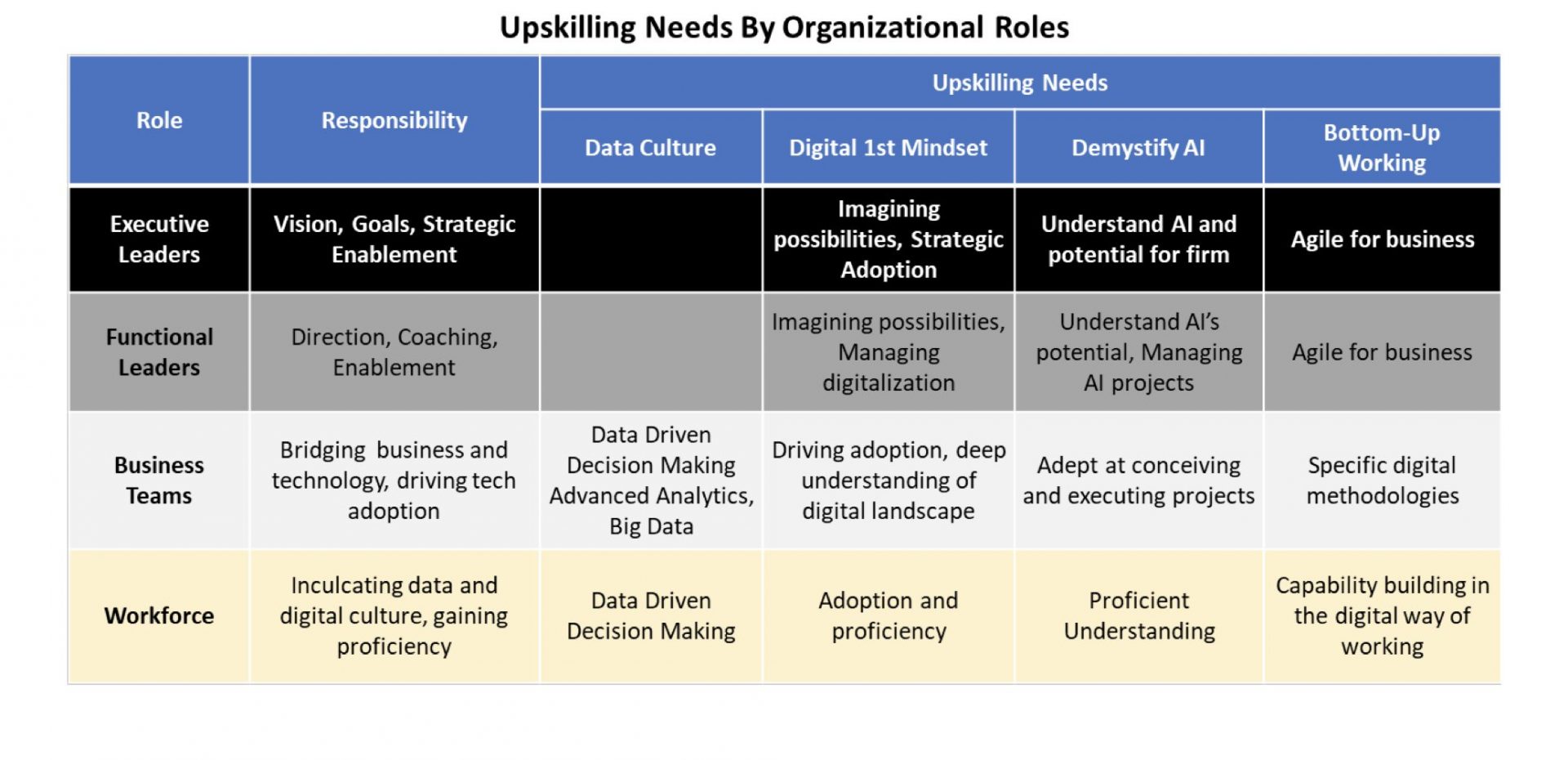360 to deliver a truly superior customer experience; or Agile methodologies to successfully manage AI at scale.
Companies which have the digital culture can succeed at any of these new technologies including AI, while for others scaling the benefits of new technology tools is really hard. AI needs business managers at the operational levels to work with IT or AI tech teams to pinpoint processes that are right for AI. They need to make an estimation based on historic data of what specific problems require and AI solution. This is enabled by the digital-first mindset. Upskilling the workforce in this mindset lays the foundation for successful AI implementation at scale.
3. Demystify AI
The next step is to get business leaders, functional leaders and business operational teams, not just those who work with AI, to acquire a basic understanding of AI . Along with upskilling business teams to inculcate the digital culture, one also needs to upskill the business teams to become adept at AI.
They do not need to learn the intricacies of programming or how to create neural networks or anything of that technical a nature. However, all levels from the leadership down should have a solid understanding of what AI can do, the basics of how it works, how the process of training data results in improved outcomes and so on. They need to understand the continuous learning nature of AI solutions, getting better over time. While AI tools may recommend an answer, human insight is often needed to make a correct decision off this recommendation.
Demystifying AI helps to clearly visualize the possibilities – driving an AI vision and strategy, define workable projects and understand how long they are likely to take. Business managers are able to manage such projects and working with the technology teams, deliver good outcomes.
Many leading organizations have already started down the path of such upskilling programs. For example, the Wall Street Journal reported that Bosch would be training over 20,000 staff including managers in AI8. There is an increased focus on democratizing AI services by leading AI providers. Leaders need to focus on upskilling so their organizations can use these services effectively.
4. Drive implementation Bottom-Up
A lot of the literature on AI focuses on the need for alignment, objectives, strategy and leadership. It talks about the human issues. But rarely have we seen a reference to what we consider the most important aspect of building scalable AI – which is letting projects run bottom up.
A reputed healthcare provider one of us worked with, embarked on a multi-year AI project to improve productivity. They wanted to use Natural Language Processing, Discovery, Cognitive Assist and ML to augment clinical proficiency of doctors and expected significant benefits in new drug discovery and trials by using the massive data sets available with them built over the previous 20 years.
The company ran this like any other transformation project, with a central program management team taking the lead with the help of an AI Center of Competency (COC). These two teams developed a compelling business case, identified initial pilots aligned with the long-term objectives of the program. However, after 18 months, they had very few tangible outcomes. Everyone
including doctors, research scientists, technicians and administrators, who participated in the program had their own interpretation of what AI was not able to do.
Discussion revealed that the doctors and researchers felt that they were training AI to replace themselves. Seeing a tool trying to mimic the same access and understanding of numerous documents baffled them at best. They were not ready to work with AI programs step by step to help AI tools learn and discover new insights.
At this point, we suggested approaching the project bottom-up – wherein the participating teams would decide specific projects to take up. This developed a culture where teams collaborated as well as competed, with each other, in finding new ways to use AI. Employees were shown a roadmap of how their jobs would be enhanced by offloading routine decisions to AI. They were shown that AI tools augment the employee’s cognitive capabilities, that embracing AI made them more effective. In short AI was “demystified”.
The team working on critical trials found these tools extremely useful and were able to collaborate with other organizations specializing in similar trials. They created the metadata and used ML algorithms to discover new insight. Working bottom up led to a very successful AI deployment.
We have seen time and again that while leadership may set the strategy and objectives, it is best to let the teams work bottom-up to come up with the projects to implement. To make this bottom-up approach work once again upskilling is required and some changes are needed in the ways of working. Agile methodologies for example, are critical to driving projects bottom-up.
Conclusion : Upskilling is the common glue
While successful AI at scale, requires much to be done, many bridges to be crossed, the four actions describer earlier are critical to building the AI powered, future-proof, enterprise. These four “keys” are all human related and each require specific kinds of upskilling as shown in the figure below. The figure shows how upskilling needs vary by organizational level and the key being addressed. However, it drives home our key point that upskilling is a universal requirement for driving AI at scale, successfully.




